|
The southern trail begins at the White House Visitor Center and proceeds onto the Ellipse grounds in a clockwise walk around the grounds.This page lists some of the features you will find in the park. For areas north of the White House, in Lafayette Park, check out the northern trail. Please note that temporary area closures may occur without notice, which may affect your ability to access areas of the park. 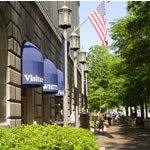
NPS White House Visitor CenterThe White House Visitor Center is operated by the National Park Service and is located at the north end of the Department of Commerce Building in Malcolm Baldrige Hall, originally called the Great Hall. Mr. Baldrige was Secretary of Commerce from 1981 to 1985 during Ronald Reagan's presidency. Construction of the Commerce building began on October 4, 1927, when Herbert C. Hoover was the Secretary of Commerce. The cornerstone was laid on July 10, 1929, when Hoover was President, and the building was completed in 1932. The Great Hall, 225 feet long and 62 feet wide, was originally used as the Patent Search Room for more than three million patents catalogued by the Department of Commerce. In celebration of our country's two hundredth birthday, the Hall became the Bicentennial Visitor Center in 1976. Until 1989, it housed the Washington Tourist Information Center. Renovations began in July 1993 with the restoration of the ornate plaster ceiling. The intent was to restore the simple elegance of the Great Hall. The original Indiana limestone walls, bronze doors, Vermont marble base and accent flooring, and Italianate bronze chandeliers were cleaned and refurbished. The center opened in March 1995. It is designed to offer a welcoming experience and provide visitors with history and information the White House and President's Park. It is open seven days a week from 7:30 a.m. to 4 p.m. and is closed on Thanksgiving, Christmas and New Year's Day. The White House Historical Association has a museum shop in the Visitor Center. 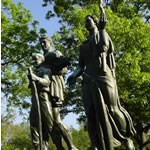
NPS Boy Scout MemorialThe memorial to the Boy Scouts of America stands on the site of the first Boy Scout Jamboree in 1937. It is one of the few memorials in Washington, D.C. commemorating a living cause. The funds to build this memorial were raised by Scout units throughout the United States, and each donor signed one of several scrolls that were placed in the pedestal of the statue. The memorials was unveiled in a ceremony on November 7, 1964. The statue was accepted for the country by Associate Supreme Court Justice Tom Clark, who noted that the day marked his fiftieth anniversary as an Eagle Scout. The bronze statue consists of three figures. The Boy Scout represents the aspirations of all past, present, and future Scouts throughout the world. The male figure exemplifies physical, mental, and moral fitness, love of country, good citizenship, loyalty, honor, and courage. He carries a helmet, a symbol of masculine attire. The female figure symbolizes enlightenment with the love of God and fellow man, justice, freedom, and democracy. She holds the eternal flame of God's Holy Spirit. 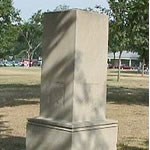
NPS Original Patentees MemorialThe National Society of the Daughters of the American Revolution donated the Settlers of the District of Columbia Memorial in April 1935 "as a way of teaching history." The simple granite shaft stands near the sidewalk along Fifteenth Street. Its purpose is to remember the original eighteen patentees "prior to 1700 whose land grants embraced the site of the federal city." A patentee is someone to whom a grant is given. In this case, the grant was ownership of land that became the District of Columbia. Each side of the monument contains a relief panel carved with a symbol of the early pioneers' agricultural pursuits. On the east side is a tobacco plant, on the south a wild turkey, on the west a stalk of corn, and on the north a fish. The names of the original landowners are inscribed on the base. 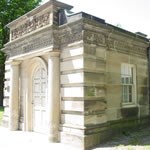
NPS Bulfinch GatehousesBuilt in 1828, these sandstone guardians silently watched over the U.S. Capitol grounds until 1874. In 1889, this gatehouse and its twin, located on Seventeenth Street and Constitution Avenue, were reconstructed in their present locations. These houses have weathered several floods, water, and the effects of acid rain. On the southeast side are markers indicating the high-water marks during floods. 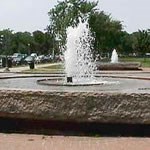
NPS Haupt FountainsFirst Lady Claudia Taylor (Lady Bird) Johnson created the Committee for a More Beautiful Capital. Part of her dream was to "frame the White House in water." Each fountain is made from an enormous slab of granite 18 feet square, nearly a foot thick, and weighing 55 tons. The granite was quarried in Morton, Minnesota, from rock more than 3.5 million years old. These rainbow granite monoliths were a gift of publishing magnate Mrs. Enid Haupt. The fountains frame the White House on the main north-south axis at Sixteenth Street and Constitution Avenue. 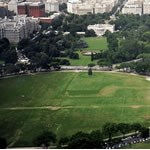
NPS The EllipseThe southern part of President's Park is the Ellipse, a large open area surrounded by an oval drive. Its development began in the 1850s but was cut short first by a lack of funds and then by the Civil War. The site has been used as horse pens, slaughterhouse and a trash dump. Soldiers were housed here during the Civil War. The Ellipse is used for many community gatherings and functions, including musical performances during the summer. Recreational activities are also held in this open area. Many demonstrations take place here, as people exercise their rights of free speech and assembly. 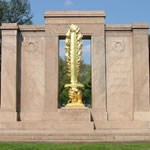
NPS Second Division MemorialThis memorial honors the 17,660 dead who served. in the Second Division of the United States Army. It was originally built to commemorate the division's casualties in World War I and was dedicated on July 18, 1936. Later, two wings were dedicated on June 20, 1962, with significant battles of World War II inscribed on the west and of the Korean War on the east. This granite shaft, built in the form of a great open doorway, has two wreaths carved in relief flanking the entrance. Guarding the gateway is an 18-foot-tall flaming sword, symbolically blocking the German advance to Paris. The Second Division's insignia, an Indian head within a star, is embossed on the sword's handle (or hilt). 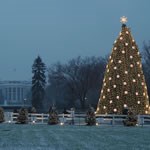
NPS / Terry Adams National Christmas TreeThe beloved tradition of the National Christmas Tree Lighting Ceremony began Christmas Eve in 1923 when President Calvin Coolidge lit a 48-foot Balsam Fir from Vermont decorated with 2,500 red, white, and green electric bulbs. Learn more about the history of the National Christmas Tree. 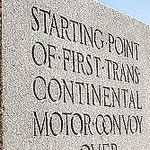
NPS Zero MilestoneThis four-foot-high shaft of pink granite stands on the north and south meridian of the District of Columbia. It is symbolically the official starting point for measurement of highway distances from Washington, D.C. On July 7, 1919, the first transcontinental military motor convoy, destined from San Francisco, California, started from this spot. On June 5, 1920, Congress authorized the erection of a permanent monument here, and the Lee Highway Association presented it as a gift to the city on June 4, 1923. All four sides of the monument are inscribed, and there is a bronze compass on top. 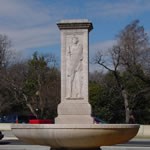
NPS Butt-Millet Memorial FountainThis fountain was erected with the contributions of friends of Major Archibald Wallingham Butt and Francis Davis Millet, who lost their lives on the RMS Titanic in April 1912. Both were widely know in Washington's cultural, social, and political circles. Millet was a painter and a member of the Fine Arts Commission. He also directed the American Academy in Rome, Italy. Major Butt had been a military aide to both President Theodore Roosevelt and William Howard Taft. The fountain is not far from where Major Butt's White House office was located. The military figure with sword and shield represents Major Butt, and the artist with palette and brush represents Mr. Millet. Besides being a memorial, the fountain was designed to double as a water fountain for the horses ridden by U.S. Park Police while on patrol. 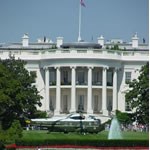
NPS White House South LawnFor more than two hundred years, each president has left a unique mark on the grounds of the White House. The grounds reveal a rich and colorful history. They were dreamed of by George Washington, defined by Thomas Jefferson, drained and filled by Ulysses S. Grant, and enriched with color and cover by many caretakers through the years. During the administration of John Quincy Adams, the first floral garden and ornamental trees were planted in 1825. Early in the morning the president liked to dig in the flower beds and claimed in his diary to have planted more than a thousand trees here before he left office. His successor, Andrew Jackson, continued and expanded the garden program, completing garden for kitchen and pleasure, as well as an orangery, where healthful fruits matured in the cold months. In 1913 First Lady Ellen Wilson, first wife of President Woodrow Wilson, had a formal rose garden created just outside the West Wing of the White House. The Rose Garden was redesigned and expanded by President John F. Kennedy as an area to host presidential functions and accommodate outdoor ceremonies. In the 1960s, Mrs. Lyndon Johnson reconfigured the East Garden to feature seasonal flowers and dedicated it to Jacqueline Kennedy. The South Lawn today is the site of many formal and informal functions. The president's helicopter lands here. Youth activities, including the annual Easter Egg Roll and T-ball games, are also held on these grounds. The First Family can enjoy the swimming pool, a small putting green, a jogging track, and a tennis court, all located on the South Grounds. Mrs. Lyndon Johnson also created the Children's Garden, a quiet, child-scaled retreat with a fish pool. Some of the paving stones are bronze castings of hands and footprints of children and grand-childrens of Presidents over the past thirty-five years. The responsibility for the preservation and upkeep of the White House grounds was given to the National Park Service in 1961 by the U.S. Congress. 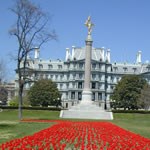
NPS First Division MonumentThis memorial proclaims the heroism of the soldiers of the First Division of the American Expeditionary Forces who gave their lives during World War I. The monument was dedicated by President Calvin Coolidge on October 4, 1924. Additions to the memorial were made in 1957 to honor the dead from World War II, in 1977 to honor those who died in the Vietnam War, and in 1995 to honor those who died in Desert Storm. The most recent additions dedicated in 2024, honor those who died in Operation Iraqi Freedom and Operation New Dawn, and Operation Enduring Freedom. The symbol of the First Division is "the Big Red One." A bed of red flowers in front of the memorial spells out a huge numeral one from spring to fall. The symbol is modeled after the "Big Red One" in the center of the division's patch. This pink Milford granite column from Massachusetts is one of the largest pieces ever taken from a quarry in the United States. Standing atop the sphere is a 15-foot-tall, gilded bronze figure of Victory. She is supported by wings, suggesting the perfection of body and soul. In her right hand she carries a flag, while her left extends in a blessing of the dead. Lafayette ParkExplore the Northern Trail |
Last updated: August 28, 2025
